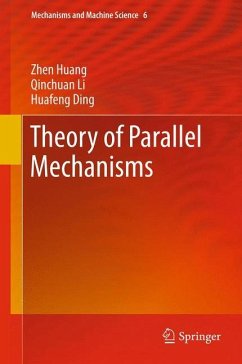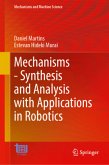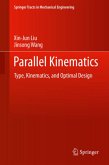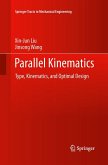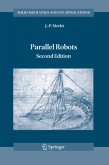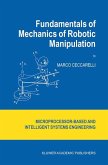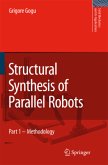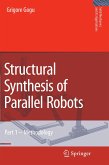- Gebundenes Buch
- Merkliste
- Auf die Merkliste
- Bewerten Bewerten
- Teilen
- Produkt teilen
- Produkterinnerung
- Produkterinnerung
This book contains mechanism analysis and synthesis.
In mechanism analysis, a mobility methodology is first systematically presented. This methodology, based on the author's screw theory, proposed in 1997, of which the generality and validity was only proved recently, is a very complex issue, researched by various scientists over the last 150 years. The principle of kinematic influence coefficient and its latest developments are described. This principle is suitable for kinematic analysis of various 6-DOF and lower-mobility parallel manipulators. The singularities are classified by a new…mehr
Andere Kunden interessierten sich auch für
![Mechanisms-Synthesis and Analysis with Applications in Robotics Mechanisms-Synthesis and Analysis with Applications in Robotics]() Daniel MartinsMechanisms-Synthesis and Analysis with Applications in Robotics75,99 €
Daniel MartinsMechanisms-Synthesis and Analysis with Applications in Robotics75,99 €![Parallel Kinematics Parallel Kinematics]() Xin-Jun LiuParallel Kinematics75,99 €
Xin-Jun LiuParallel Kinematics75,99 €![Parallel Kinematics Parallel Kinematics]() Xin-Jun LiuParallel Kinematics75,99 €
Xin-Jun LiuParallel Kinematics75,99 €![Parallel Robots Parallel Robots]() J.-P. MerletParallel Robots130,99 €
J.-P. MerletParallel Robots130,99 €![Fundamentals of Mechanics of Robotic Manipulation Fundamentals of Mechanics of Robotic Manipulation]() Marco CeccarelliFundamentals of Mechanics of Robotic Manipulation90,99 €
Marco CeccarelliFundamentals of Mechanics of Robotic Manipulation90,99 €![Structural Synthesis of Parallel Robots Structural Synthesis of Parallel Robots]() Grigore GoguStructural Synthesis of Parallel Robots115,99 €
Grigore GoguStructural Synthesis of Parallel Robots115,99 €![Structural Synthesis of Parallel Robots Structural Synthesis of Parallel Robots]() Grigore GoguStructural Synthesis of Parallel Robots113,99 €
Grigore GoguStructural Synthesis of Parallel Robots113,99 €-
-
-
This book contains mechanism analysis and synthesis.
In mechanism analysis, a mobility methodology is first systematically presented. This methodology, based on the author's screw theory, proposed in 1997, of which the generality and validity was only proved recently, is a very complex issue, researched by various scientists over the last 150 years. The principle of kinematic influence coefficient and its latest developments are described. This principle is suitable for kinematic analysis of various 6-DOF and lower-mobility parallel manipulators. The singularities are classified by a new point of view, and progress in position-singularity and orientation-singularity is stated. In addition, the concept of over-determinate input is proposed and a new method of force analysis based on screw theory is presented.
In mechanism synthesis, the synthesis for spatial parallel mechanisms is discussed, and the synthesis method of difficult 4-DOF and 5-DOF symmetric mechanisms, which was first put forward by the author in 2002, is introduced in detail. Besides, the three-order screw system and its space distribution of the kinematic screws for infinite possible motions of lower mobility mechanisms are both analyzed.
In mechanism analysis, a mobility methodology is first systematically presented. This methodology, based on the author's screw theory, proposed in 1997, of which the generality and validity was only proved recently, is a very complex issue, researched by various scientists over the last 150 years. The principle of kinematic influence coefficient and its latest developments are described. This principle is suitable for kinematic analysis of various 6-DOF and lower-mobility parallel manipulators. The singularities are classified by a new point of view, and progress in position-singularity and orientation-singularity is stated. In addition, the concept of over-determinate input is proposed and a new method of force analysis based on screw theory is presented.
In mechanism synthesis, the synthesis for spatial parallel mechanisms is discussed, and the synthesis method of difficult 4-DOF and 5-DOF symmetric mechanisms, which was first put forward by the author in 2002, is introduced in detail. Besides, the three-order screw system and its space distribution of the kinematic screws for infinite possible motions of lower mobility mechanisms are both analyzed.
Produktdetails
- Produktdetails
- Mechanisms and Machine Science 6
- Verlag: Springer / Springer Netherlands
- Artikelnr. des Verlages: 12824731, 978-94-007-4200-0
- 2013
- Seitenzahl: 436
- Erscheinungstermin: 26. Juli 2012
- Englisch
- Abmessung: 241mm x 160mm x 28mm
- Gewicht: 793g
- ISBN-13: 9789400742000
- ISBN-10: 9400742002
- Artikelnr.: 34889690
- Herstellerkennzeichnung
- Springer-Verlag GmbH
- Tiergartenstr. 17
- 69121 Heidelberg
- ProductSafety@springernature.com
- Mechanisms and Machine Science 6
- Verlag: Springer / Springer Netherlands
- Artikelnr. des Verlages: 12824731, 978-94-007-4200-0
- 2013
- Seitenzahl: 436
- Erscheinungstermin: 26. Juli 2012
- Englisch
- Abmessung: 241mm x 160mm x 28mm
- Gewicht: 793g
- ISBN-13: 9789400742000
- ISBN-10: 9400742002
- Artikelnr.: 34889690
- Herstellerkennzeichnung
- Springer-Verlag GmbH
- Tiergartenstr. 17
- 69121 Heidelberg
- ProductSafety@springernature.com
Part I Screw Theory.
Chapter 1 Basics of Screw Theory.
Introduction.
1.1 Equation of a Line.
1.2 Mutual Moment of Two Lines.
1.3 Line Vectors and Screws.
1.3.1 The line vector.
1.3.2 The screw.
1.4 Screw Algebra.
1.4.1 Screw Sum.
1.4.2 Product of a scalar and a screw.
1.4.3 Reciprocal Product.
1.5 Instantaneous Kinematics of a Rigid Body.
1.5.1 Instantaneous Rotation.
1.5.2 Instantaneous Translation.
1.5.3 Instantaneous screw motion.
1.6 Statics of a Rigid Body.
1.6.1 A Force Acting on a Body.
1.6.2 A Couple Acting on a Body.
1.6.3 A Twist Acting on a Body.
References.
Chapter 2 Dependency and Reciprocity of Screws.
2.1 Concept of Screw Systems.
2.2 Second
order screw system.
2.2.1 Linear combination of two screws.
2.2.2 Special two
screw system.
2.3 Third
order screw system.
2.3.1 Principal screws.
2.3.2 Special three
screw systems.
2.4 Grassmann line geometry.
2.5 Screw dependency in different geometrical spaces.
2.5.1 Basic concepts.
2.5.2 Different geometrical spaces.
2.6 Reciprocal screws.
2.6.1 Concept of a reciprocal screw.
2.6.2 Dualism in the physical meaning of reciprocal screws.
2.7 Reciprocal screw system.
2.8 Reciprocal screw and constrained motion.
2.8.1 Three skew lines in space.
2.8.2 Three lines parallel to a plane without a common normal.
2.8.3 Three non
concurrent coplanar lines.
2.8.4 Three coplanar and concurrent line vectors.
2.8.5 Three line vectors concurrent in space.
2.8.6 Three line vectors parallel in space.
References.
Chapter 3 Mobility Analysis (Part 1).
3.1 The Concept and Definition of Mobility.
3.2 Mobility Open Issue.
3.2.1 Grübler
Kutzbach Criterion.
3.2.2 Mobility Open Issue.
3.3 Mobility Principle based on Reciprocal Screw.
3.3.1 Mechanism Can Be Expressed as a Screw System.
3.3.2. Development of Our Unified Mobility Principle.
3.3.3 The Modified G
K Formulas.
3.4 Constraint Analysis based on Reciprocal Screw.
3.4.1 The Common Constraint.
3.4.2 Parallel Constraint.
3.4.3. Over
constraint.
3.4.4. The Generalized Kinematic Pair.
3.5 Mobility Property Analyses.
3.5.1 Translation and Rotation.
3.5.2 Rotational Axis.
3.5.3 Instantaneous Mobility and Full
cycle Mobility.
3.5.4 Full
field Mobility.
3.5.5 Parasitic Motion.
3.5.6 Self
motion.
References.
Chapter 4 Mobility Analysis Part 2.
4.1 Mobility analysis of simple mechanisms.
4.1.1 Open Chain linkage.
4.1.2 Roberval mechanism.
4.1.3 RUPUR mechanism.
4.1.4 Hervé 6.bar mechanism.
4.1.5 Spatial 4P mechanism.
4.1.6 Delassus H
H
H
H Mechanism.
4.1.7 Hervé's CCC Mechanism.
4.2 Mobility Analysis of classical mechanisms.
4.2.1 Bennett mechanism.
4.2.2 Five
bar Goldberg Linkage.
4.2.3 Six
bar Goldberg linkage.
4.2.4 Myard linkage with symmetrical plane.
4.2.5 Bricard with symmetrical plane.
4.2.6 Altmann Abb.34 Mechanism.
4.2.7 Altmann six
bar linkage.
4.2.8 Waldron six
bar linkage.
4.3 Mobility Analysis of Modern Parallel Mechanisms.
4.3.1 4
DOF 4
URU Mechanism.
4.3.2 3
CRR mechanism.
4.3.3 Zlatanov and Gosselin's Mechanism.
4.3.4 Carricato's mechanism.
4.3.5 Delta mechanism.
4.3.6 H4 manipulator.
4.3.7 Yang's mechanism.
4.4 Mobility analysis of Hoberman Switch
pitch ball.
4.4.1 Structure analysis.
4.4.2 Three
link chain.
4.4.3 Eight
link loop.
4.4.4 Double loop.
4.4.5 Three
loop chain.
4.4.6 The whole mechanism.
4.5 Six
hole cubiform mechanism.
4.5.1 Double
hole linkage.
4.5.2 Four
hole linkage.
4.5.3 five
hole linkage.
4.5.4 The whole six
hole mechanism.
References.
Chapter 5 Kinematic Influence Coefficient and Kinematics Analysis.
5.1 Concept of KIC.
5.2 KIC and Kinematic Analysis of Serial Chains.
5.2.1 Position Analysis.
5.2.2 First
Order KIC.
5.2.3 Second
Order KIC.
5.3 Kinematic Analysis of Parallel Mechanism.
5.3.1 First
Order KIC and Mechanism Velocity Analysis.
5.3.2 Second
Order KIC and Mechanism Accelerations.
5.4 Virtual Mechanism Principle of Lower
Mobility Parallel Mechanisms.
5.4.1 Virtual Mechanism Principle.
5.4.2 Kinematic Analysis Based on Virtual Mechanism Principle.
Fig. 5.7 A virtual limb.
References.
Chapter 6 Full
Scale Feasible Instantaneous Screw Motion.
6.1. Introduction.
6.2. Determination of Principal Screws.
6.2.1 The Representation of pitch and axes.
6.2.2 Principal screws of a third
order screw system.
6.3. Full
Scale Feasible Instantaneous Screws of the 3
RPS mechanism.
6.3.1. Virtual Mechanism and Jacobian Matrix.
6.3.2 Upper platform is parallel to the base.
6.3.3 The upper platform rotates by an angle about line a2a3.
6.3.4 General configuration of the 3
RPS mechanism.
6.4. Full
Scale Feasible Instantaneous Screw of a 3
UPU mechanism.
6.4.1 Mobility analysis.
6.4.2 First
order influence matrices and kinematic analysis.
6.4.3. Initial configuration.
6.4.4 The second configuration.
6.5 Full
Scale Feasible Instantaneous Screw of a 3
RPS Pyramid mechanism.
6.5.1 First
order influence coefficient matrix (Jacobian matrix).
6.5.2 Principal screws and full
scale feasible motions.
6.6 A 3
DOF Rotational Parallel Manipulator without Intersecting Axes.
6.6.1 An Open Problem of the PMs with Intersecting Axes.
6.6.2 A 3
D revolute mechanism without intersecting axes.
6.3.3 The Orientation Workspace.
6.6.4 Examples.
6.6.5 Discussions about the differences between the SPMs and the 3
RPS Cubic PM.
References.
Chapter 7 special configuration of Mechanisms.
7.1. Introduction.
7.2. Classification of the Special Configuration.
7.2.1 Singular kinematics classification.
7.2.2 Classification of the Singularity via a Linear Complex.
7.3. Singular Kinematic Principle.
7.4. Singularity Loci of 3/6
Stewart For special orientations.
7.4.1 Typical Singularity Structures of 3/6
SP.
7.4.2 Hyperbolic Singularity Equation Derived in an Oblique Plane.
7.4.3 Singularity Equation Derived in 3D Space.
7.4.4 Singularity Distribution in 3D Space.
7.5. Structure and Property of THE Singularity Loci of 3/6
Stewart for General Orientations ( ).
7.5.1. Singularity Equation Based on Theorem 3 for General Orientations.
7.5.2 Singularity Analysis Using Singularity
Equivalent
Mechanism.
7.5.3. General Case.
7.5.4 Five Special Cases of the Singularity Equation.
7.6. Structure and Property of the Singularity Loci of the 6/6
Stewart.
7.6.1 Jacobian Matrix.
7.6.2 Singularity Analysis in 3D Space.
7.6.3 Singularity Analysis in Parallel Principal
Sections.
7.7 Singularity of a 3
RPS Manipulator.
7.7.1 3
RPS Mechanism.
7.7.2. Singularity and Its spatial distribution.
7.7.3. Geometry and Constraint Analysis.
References.
Appendix A.
Chapter 8 Dynamic Problems of Parallel Mechanisms.
8.1 Over
determine inputs.
8.1.1 Influence coefficient matrices and inertia forces.
8.1.2 The Accordant Equation for over
determinate Inputs.
8.1.3 Optimization of Over
Determinate Input.
8.1.4 The Weight Distribution of the input Torques.
8.2 Kinetostatic Analysis of 4
UPU Parallel Mechanisms.
8.2.1 Main
pair reaction Forces.
8.2.2 Numerical Example.
8.3 Kinetostatic Analysis of 4
R(CRR) Parallel Manipulator.
8.3.1 4
R(CRR) Parallel Manipulator.
8.3.2. Main
pair reaction.
8.3.3 Active moments and reactions of other pairs in limbs.
8.3.4 Numerical example.
8.3.5. Discussion.
References.
Chapter 9 Constraint screw
based method for type synthesis.
9.1 Description of constraints acting on a rigid body.
9.2 Limb twist and limb constraint systems.
9.2.1 Limb twist system.
9.2.2 Limb constraint system.
9.3 Platform twist and platform constraint systems.
9.3.1 Platform twist system.
9.3.2 Platform constraint system and classification of lower
mobility PMs.
9. 4 Constraint
screw based synthesis method.
9.4.1 Procedure of the constraint
screw based synthesis method.
9.4.2 Generation of different architectures of PM.
9.4.3 Discrimination for instantaneous PMs.
9.5 Examples.
9.5.1 Type synthesis of a 3R2T 5
DOF PM.
9. 5. 2 Type synthesis of 2R3T 5
DOF PMs.
9. 5. 3 Type synthesis of 1R3T 4
DOF PMs.
9. 5. 4 Type synthesis of 3R1T 4
DOF PMs.
9. 5. 6 Type synthesis of a 2R1T 3
DOF PM.
9. 5. 7 Type synthesis of a 3T 3
DOF PM.
9. 5. 8 Type synthesis of a 3R 3
DOF PM.
9. 5. 9 Type synthesis of a 1R2T 3
DOF PM.
References.
Chapter 10 Digital Topology Theory of Kinematic Chains and Atlas Database.
10
1 Topology Modeling of Mechanisms.
10.1.1 Modeling of simple joint kinematic chains.
10.1.2 Modeling of multiple joint kinematic chains.
10.1.3 Modeling of geared (cam) kinematic chains.
10.2 Loop operation algebra of kinematic chains.
10.2.1 Loop and its representation.
10.2.2 " " Operation of Loops.
10.2.3 " " Operation of Loops.
10.2.5 Loop analysis.
10.2.6 Edge
based operations of loops.
10.3 Isomorphism identification.
10.3.1 Perimeter topological graph.
10.3.2 Canonical perimeter topological graph.
10.3.3 Characteristic perimeter topological graph.
10.3.4 Examples of isomorphism identification.
10.3.5 Analysis of computational complexity.
10.4 Detection of rigid sub
chains.
10.5 Digital atlas database and synthesis.
References.
Index.
Chapter 1 Basics of Screw Theory.
Introduction.
1.1 Equation of a Line.
1.2 Mutual Moment of Two Lines.
1.3 Line Vectors and Screws.
1.3.1 The line vector.
1.3.2 The screw.
1.4 Screw Algebra.
1.4.1 Screw Sum.
1.4.2 Product of a scalar and a screw.
1.4.3 Reciprocal Product.
1.5 Instantaneous Kinematics of a Rigid Body.
1.5.1 Instantaneous Rotation.
1.5.2 Instantaneous Translation.
1.5.3 Instantaneous screw motion.
1.6 Statics of a Rigid Body.
1.6.1 A Force Acting on a Body.
1.6.2 A Couple Acting on a Body.
1.6.3 A Twist Acting on a Body.
References.
Chapter 2 Dependency and Reciprocity of Screws.
2.1 Concept of Screw Systems.
2.2 Second
order screw system.
2.2.1 Linear combination of two screws.
2.2.2 Special two
screw system.
2.3 Third
order screw system.
2.3.1 Principal screws.
2.3.2 Special three
screw systems.
2.4 Grassmann line geometry.
2.5 Screw dependency in different geometrical spaces.
2.5.1 Basic concepts.
2.5.2 Different geometrical spaces.
2.6 Reciprocal screws.
2.6.1 Concept of a reciprocal screw.
2.6.2 Dualism in the physical meaning of reciprocal screws.
2.7 Reciprocal screw system.
2.8 Reciprocal screw and constrained motion.
2.8.1 Three skew lines in space.
2.8.2 Three lines parallel to a plane without a common normal.
2.8.3 Three non
concurrent coplanar lines.
2.8.4 Three coplanar and concurrent line vectors.
2.8.5 Three line vectors concurrent in space.
2.8.6 Three line vectors parallel in space.
References.
Chapter 3 Mobility Analysis (Part 1).
3.1 The Concept and Definition of Mobility.
3.2 Mobility Open Issue.
3.2.1 Grübler
Kutzbach Criterion.
3.2.2 Mobility Open Issue.
3.3 Mobility Principle based on Reciprocal Screw.
3.3.1 Mechanism Can Be Expressed as a Screw System.
3.3.2. Development of Our Unified Mobility Principle.
3.3.3 The Modified G
K Formulas.
3.4 Constraint Analysis based on Reciprocal Screw.
3.4.1 The Common Constraint.
3.4.2 Parallel Constraint.
3.4.3. Over
constraint.
3.4.4. The Generalized Kinematic Pair.
3.5 Mobility Property Analyses.
3.5.1 Translation and Rotation.
3.5.2 Rotational Axis.
3.5.3 Instantaneous Mobility and Full
cycle Mobility.
3.5.4 Full
field Mobility.
3.5.5 Parasitic Motion.
3.5.6 Self
motion.
References.
Chapter 4 Mobility Analysis Part 2.
4.1 Mobility analysis of simple mechanisms.
4.1.1 Open Chain linkage.
4.1.2 Roberval mechanism.
4.1.3 RUPUR mechanism.
4.1.4 Hervé 6.bar mechanism.
4.1.5 Spatial 4P mechanism.
4.1.6 Delassus H
H
H
H Mechanism.
4.1.7 Hervé's CCC Mechanism.
4.2 Mobility Analysis of classical mechanisms.
4.2.1 Bennett mechanism.
4.2.2 Five
bar Goldberg Linkage.
4.2.3 Six
bar Goldberg linkage.
4.2.4 Myard linkage with symmetrical plane.
4.2.5 Bricard with symmetrical plane.
4.2.6 Altmann Abb.34 Mechanism.
4.2.7 Altmann six
bar linkage.
4.2.8 Waldron six
bar linkage.
4.3 Mobility Analysis of Modern Parallel Mechanisms.
4.3.1 4
DOF 4
URU Mechanism.
4.3.2 3
CRR mechanism.
4.3.3 Zlatanov and Gosselin's Mechanism.
4.3.4 Carricato's mechanism.
4.3.5 Delta mechanism.
4.3.6 H4 manipulator.
4.3.7 Yang's mechanism.
4.4 Mobility analysis of Hoberman Switch
pitch ball.
4.4.1 Structure analysis.
4.4.2 Three
link chain.
4.4.3 Eight
link loop.
4.4.4 Double loop.
4.4.5 Three
loop chain.
4.4.6 The whole mechanism.
4.5 Six
hole cubiform mechanism.
4.5.1 Double
hole linkage.
4.5.2 Four
hole linkage.
4.5.3 five
hole linkage.
4.5.4 The whole six
hole mechanism.
References.
Chapter 5 Kinematic Influence Coefficient and Kinematics Analysis.
5.1 Concept of KIC.
5.2 KIC and Kinematic Analysis of Serial Chains.
5.2.1 Position Analysis.
5.2.2 First
Order KIC.
5.2.3 Second
Order KIC.
5.3 Kinematic Analysis of Parallel Mechanism.
5.3.1 First
Order KIC and Mechanism Velocity Analysis.
5.3.2 Second
Order KIC and Mechanism Accelerations.
5.4 Virtual Mechanism Principle of Lower
Mobility Parallel Mechanisms.
5.4.1 Virtual Mechanism Principle.
5.4.2 Kinematic Analysis Based on Virtual Mechanism Principle.
Fig. 5.7 A virtual limb.
References.
Chapter 6 Full
Scale Feasible Instantaneous Screw Motion.
6.1. Introduction.
6.2. Determination of Principal Screws.
6.2.1 The Representation of pitch and axes.
6.2.2 Principal screws of a third
order screw system.
6.3. Full
Scale Feasible Instantaneous Screws of the 3
RPS mechanism.
6.3.1. Virtual Mechanism and Jacobian Matrix.
6.3.2 Upper platform is parallel to the base.
6.3.3 The upper platform rotates by an angle about line a2a3.
6.3.4 General configuration of the 3
RPS mechanism.
6.4. Full
Scale Feasible Instantaneous Screw of a 3
UPU mechanism.
6.4.1 Mobility analysis.
6.4.2 First
order influence matrices and kinematic analysis.
6.4.3. Initial configuration.
6.4.4 The second configuration.
6.5 Full
Scale Feasible Instantaneous Screw of a 3
RPS Pyramid mechanism.
6.5.1 First
order influence coefficient matrix (Jacobian matrix).
6.5.2 Principal screws and full
scale feasible motions.
6.6 A 3
DOF Rotational Parallel Manipulator without Intersecting Axes.
6.6.1 An Open Problem of the PMs with Intersecting Axes.
6.6.2 A 3
D revolute mechanism without intersecting axes.
6.3.3 The Orientation Workspace.
6.6.4 Examples.
6.6.5 Discussions about the differences between the SPMs and the 3
RPS Cubic PM.
References.
Chapter 7 special configuration of Mechanisms.
7.1. Introduction.
7.2. Classification of the Special Configuration.
7.2.1 Singular kinematics classification.
7.2.2 Classification of the Singularity via a Linear Complex.
7.3. Singular Kinematic Principle.
7.4. Singularity Loci of 3/6
Stewart For special orientations.
7.4.1 Typical Singularity Structures of 3/6
SP.
7.4.2 Hyperbolic Singularity Equation Derived in an Oblique Plane.
7.4.3 Singularity Equation Derived in 3D Space.
7.4.4 Singularity Distribution in 3D Space.
7.5. Structure and Property of THE Singularity Loci of 3/6
Stewart for General Orientations ( ).
7.5.1. Singularity Equation Based on Theorem 3 for General Orientations.
7.5.2 Singularity Analysis Using Singularity
Equivalent
Mechanism.
7.5.3. General Case.
7.5.4 Five Special Cases of the Singularity Equation.
7.6. Structure and Property of the Singularity Loci of the 6/6
Stewart.
7.6.1 Jacobian Matrix.
7.6.2 Singularity Analysis in 3D Space.
7.6.3 Singularity Analysis in Parallel Principal
Sections.
7.7 Singularity of a 3
RPS Manipulator.
7.7.1 3
RPS Mechanism.
7.7.2. Singularity and Its spatial distribution.
7.7.3. Geometry and Constraint Analysis.
References.
Appendix A.
Chapter 8 Dynamic Problems of Parallel Mechanisms.
8.1 Over
determine inputs.
8.1.1 Influence coefficient matrices and inertia forces.
8.1.2 The Accordant Equation for over
determinate Inputs.
8.1.3 Optimization of Over
Determinate Input.
8.1.4 The Weight Distribution of the input Torques.
8.2 Kinetostatic Analysis of 4
UPU Parallel Mechanisms.
8.2.1 Main
pair reaction Forces.
8.2.2 Numerical Example.
8.3 Kinetostatic Analysis of 4
R(CRR) Parallel Manipulator.
8.3.1 4
R(CRR) Parallel Manipulator.
8.3.2. Main
pair reaction.
8.3.3 Active moments and reactions of other pairs in limbs.
8.3.4 Numerical example.
8.3.5. Discussion.
References.
Chapter 9 Constraint screw
based method for type synthesis.
9.1 Description of constraints acting on a rigid body.
9.2 Limb twist and limb constraint systems.
9.2.1 Limb twist system.
9.2.2 Limb constraint system.
9.3 Platform twist and platform constraint systems.
9.3.1 Platform twist system.
9.3.2 Platform constraint system and classification of lower
mobility PMs.
9. 4 Constraint
screw based synthesis method.
9.4.1 Procedure of the constraint
screw based synthesis method.
9.4.2 Generation of different architectures of PM.
9.4.3 Discrimination for instantaneous PMs.
9.5 Examples.
9.5.1 Type synthesis of a 3R2T 5
DOF PM.
9. 5. 2 Type synthesis of 2R3T 5
DOF PMs.
9. 5. 3 Type synthesis of 1R3T 4
DOF PMs.
9. 5. 4 Type synthesis of 3R1T 4
DOF PMs.
9. 5. 6 Type synthesis of a 2R1T 3
DOF PM.
9. 5. 7 Type synthesis of a 3T 3
DOF PM.
9. 5. 8 Type synthesis of a 3R 3
DOF PM.
9. 5. 9 Type synthesis of a 1R2T 3
DOF PM.
References.
Chapter 10 Digital Topology Theory of Kinematic Chains and Atlas Database.
10
1 Topology Modeling of Mechanisms.
10.1.1 Modeling of simple joint kinematic chains.
10.1.2 Modeling of multiple joint kinematic chains.
10.1.3 Modeling of geared (cam) kinematic chains.
10.2 Loop operation algebra of kinematic chains.
10.2.1 Loop and its representation.
10.2.2 " " Operation of Loops.
10.2.3 " " Operation of Loops.
10.2.5 Loop analysis.
10.2.6 Edge
based operations of loops.
10.3 Isomorphism identification.
10.3.1 Perimeter topological graph.
10.3.2 Canonical perimeter topological graph.
10.3.3 Characteristic perimeter topological graph.
10.3.4 Examples of isomorphism identification.
10.3.5 Analysis of computational complexity.
10.4 Detection of rigid sub
chains.
10.5 Digital atlas database and synthesis.
References.
Index.
Part I Screw Theory.
Chapter 1 Basics of Screw Theory.
Introduction.
1.1 Equation of a Line.
1.2 Mutual Moment of Two Lines.
1.3 Line Vectors and Screws.
1.3.1 The line vector.
1.3.2 The screw.
1.4 Screw Algebra.
1.4.1 Screw Sum.
1.4.2 Product of a scalar and a screw.
1.4.3 Reciprocal Product.
1.5 Instantaneous Kinematics of a Rigid Body.
1.5.1 Instantaneous Rotation.
1.5.2 Instantaneous Translation.
1.5.3 Instantaneous screw motion.
1.6 Statics of a Rigid Body.
1.6.1 A Force Acting on a Body.
1.6.2 A Couple Acting on a Body.
1.6.3 A Twist Acting on a Body.
References.
Chapter 2 Dependency and Reciprocity of Screws.
2.1 Concept of Screw Systems.
2.2 Second
order screw system.
2.2.1 Linear combination of two screws.
2.2.2 Special two
screw system.
2.3 Third
order screw system.
2.3.1 Principal screws.
2.3.2 Special three
screw systems.
2.4 Grassmann line geometry.
2.5 Screw dependency in different geometrical spaces.
2.5.1 Basic concepts.
2.5.2 Different geometrical spaces.
2.6 Reciprocal screws.
2.6.1 Concept of a reciprocal screw.
2.6.2 Dualism in the physical meaning of reciprocal screws.
2.7 Reciprocal screw system.
2.8 Reciprocal screw and constrained motion.
2.8.1 Three skew lines in space.
2.8.2 Three lines parallel to a plane without a common normal.
2.8.3 Three non
concurrent coplanar lines.
2.8.4 Three coplanar and concurrent line vectors.
2.8.5 Three line vectors concurrent in space.
2.8.6 Three line vectors parallel in space.
References.
Chapter 3 Mobility Analysis (Part 1).
3.1 The Concept and Definition of Mobility.
3.2 Mobility Open Issue.
3.2.1 Grübler
Kutzbach Criterion.
3.2.2 Mobility Open Issue.
3.3 Mobility Principle based on Reciprocal Screw.
3.3.1 Mechanism Can Be Expressed as a Screw System.
3.3.2. Development of Our Unified Mobility Principle.
3.3.3 The Modified G
K Formulas.
3.4 Constraint Analysis based on Reciprocal Screw.
3.4.1 The Common Constraint.
3.4.2 Parallel Constraint.
3.4.3. Over
constraint.
3.4.4. The Generalized Kinematic Pair.
3.5 Mobility Property Analyses.
3.5.1 Translation and Rotation.
3.5.2 Rotational Axis.
3.5.3 Instantaneous Mobility and Full
cycle Mobility.
3.5.4 Full
field Mobility.
3.5.5 Parasitic Motion.
3.5.6 Self
motion.
References.
Chapter 4 Mobility Analysis Part 2.
4.1 Mobility analysis of simple mechanisms.
4.1.1 Open Chain linkage.
4.1.2 Roberval mechanism.
4.1.3 RUPUR mechanism.
4.1.4 Hervé 6.bar mechanism.
4.1.5 Spatial 4P mechanism.
4.1.6 Delassus H
H
H
H Mechanism.
4.1.7 Hervé's CCC Mechanism.
4.2 Mobility Analysis of classical mechanisms.
4.2.1 Bennett mechanism.
4.2.2 Five
bar Goldberg Linkage.
4.2.3 Six
bar Goldberg linkage.
4.2.4 Myard linkage with symmetrical plane.
4.2.5 Bricard with symmetrical plane.
4.2.6 Altmann Abb.34 Mechanism.
4.2.7 Altmann six
bar linkage.
4.2.8 Waldron six
bar linkage.
4.3 Mobility Analysis of Modern Parallel Mechanisms.
4.3.1 4
DOF 4
URU Mechanism.
4.3.2 3
CRR mechanism.
4.3.3 Zlatanov and Gosselin's Mechanism.
4.3.4 Carricato's mechanism.
4.3.5 Delta mechanism.
4.3.6 H4 manipulator.
4.3.7 Yang's mechanism.
4.4 Mobility analysis of Hoberman Switch
pitch ball.
4.4.1 Structure analysis.
4.4.2 Three
link chain.
4.4.3 Eight
link loop.
4.4.4 Double loop.
4.4.5 Three
loop chain.
4.4.6 The whole mechanism.
4.5 Six
hole cubiform mechanism.
4.5.1 Double
hole linkage.
4.5.2 Four
hole linkage.
4.5.3 five
hole linkage.
4.5.4 The whole six
hole mechanism.
References.
Chapter 5 Kinematic Influence Coefficient and Kinematics Analysis.
5.1 Concept of KIC.
5.2 KIC and Kinematic Analysis of Serial Chains.
5.2.1 Position Analysis.
5.2.2 First
Order KIC.
5.2.3 Second
Order KIC.
5.3 Kinematic Analysis of Parallel Mechanism.
5.3.1 First
Order KIC and Mechanism Velocity Analysis.
5.3.2 Second
Order KIC and Mechanism Accelerations.
5.4 Virtual Mechanism Principle of Lower
Mobility Parallel Mechanisms.
5.4.1 Virtual Mechanism Principle.
5.4.2 Kinematic Analysis Based on Virtual Mechanism Principle.
Fig. 5.7 A virtual limb.
References.
Chapter 6 Full
Scale Feasible Instantaneous Screw Motion.
6.1. Introduction.
6.2. Determination of Principal Screws.
6.2.1 The Representation of pitch and axes.
6.2.2 Principal screws of a third
order screw system.
6.3. Full
Scale Feasible Instantaneous Screws of the 3
RPS mechanism.
6.3.1. Virtual Mechanism and Jacobian Matrix.
6.3.2 Upper platform is parallel to the base.
6.3.3 The upper platform rotates by an angle about line a2a3.
6.3.4 General configuration of the 3
RPS mechanism.
6.4. Full
Scale Feasible Instantaneous Screw of a 3
UPU mechanism.
6.4.1 Mobility analysis.
6.4.2 First
order influence matrices and kinematic analysis.
6.4.3. Initial configuration.
6.4.4 The second configuration.
6.5 Full
Scale Feasible Instantaneous Screw of a 3
RPS Pyramid mechanism.
6.5.1 First
order influence coefficient matrix (Jacobian matrix).
6.5.2 Principal screws and full
scale feasible motions.
6.6 A 3
DOF Rotational Parallel Manipulator without Intersecting Axes.
6.6.1 An Open Problem of the PMs with Intersecting Axes.
6.6.2 A 3
D revolute mechanism without intersecting axes.
6.3.3 The Orientation Workspace.
6.6.4 Examples.
6.6.5 Discussions about the differences between the SPMs and the 3
RPS Cubic PM.
References.
Chapter 7 special configuration of Mechanisms.
7.1. Introduction.
7.2. Classification of the Special Configuration.
7.2.1 Singular kinematics classification.
7.2.2 Classification of the Singularity via a Linear Complex.
7.3. Singular Kinematic Principle.
7.4. Singularity Loci of 3/6
Stewart For special orientations.
7.4.1 Typical Singularity Structures of 3/6
SP.
7.4.2 Hyperbolic Singularity Equation Derived in an Oblique Plane.
7.4.3 Singularity Equation Derived in 3D Space.
7.4.4 Singularity Distribution in 3D Space.
7.5. Structure and Property of THE Singularity Loci of 3/6
Stewart for General Orientations ( ).
7.5.1. Singularity Equation Based on Theorem 3 for General Orientations.
7.5.2 Singularity Analysis Using Singularity
Equivalent
Mechanism.
7.5.3. General Case.
7.5.4 Five Special Cases of the Singularity Equation.
7.6. Structure and Property of the Singularity Loci of the 6/6
Stewart.
7.6.1 Jacobian Matrix.
7.6.2 Singularity Analysis in 3D Space.
7.6.3 Singularity Analysis in Parallel Principal
Sections.
7.7 Singularity of a 3
RPS Manipulator.
7.7.1 3
RPS Mechanism.
7.7.2. Singularity and Its spatial distribution.
7.7.3. Geometry and Constraint Analysis.
References.
Appendix A.
Chapter 8 Dynamic Problems of Parallel Mechanisms.
8.1 Over
determine inputs.
8.1.1 Influence coefficient matrices and inertia forces.
8.1.2 The Accordant Equation for over
determinate Inputs.
8.1.3 Optimization of Over
Determinate Input.
8.1.4 The Weight Distribution of the input Torques.
8.2 Kinetostatic Analysis of 4
UPU Parallel Mechanisms.
8.2.1 Main
pair reaction Forces.
8.2.2 Numerical Example.
8.3 Kinetostatic Analysis of 4
R(CRR) Parallel Manipulator.
8.3.1 4
R(CRR) Parallel Manipulator.
8.3.2. Main
pair reaction.
8.3.3 Active moments and reactions of other pairs in limbs.
8.3.4 Numerical example.
8.3.5. Discussion.
References.
Chapter 9 Constraint screw
based method for type synthesis.
9.1 Description of constraints acting on a rigid body.
9.2 Limb twist and limb constraint systems.
9.2.1 Limb twist system.
9.2.2 Limb constraint system.
9.3 Platform twist and platform constraint systems.
9.3.1 Platform twist system.
9.3.2 Platform constraint system and classification of lower
mobility PMs.
9. 4 Constraint
screw based synthesis method.
9.4.1 Procedure of the constraint
screw based synthesis method.
9.4.2 Generation of different architectures of PM.
9.4.3 Discrimination for instantaneous PMs.
9.5 Examples.
9.5.1 Type synthesis of a 3R2T 5
DOF PM.
9. 5. 2 Type synthesis of 2R3T 5
DOF PMs.
9. 5. 3 Type synthesis of 1R3T 4
DOF PMs.
9. 5. 4 Type synthesis of 3R1T 4
DOF PMs.
9. 5. 6 Type synthesis of a 2R1T 3
DOF PM.
9. 5. 7 Type synthesis of a 3T 3
DOF PM.
9. 5. 8 Type synthesis of a 3R 3
DOF PM.
9. 5. 9 Type synthesis of a 1R2T 3
DOF PM.
References.
Chapter 10 Digital Topology Theory of Kinematic Chains and Atlas Database.
10
1 Topology Modeling of Mechanisms.
10.1.1 Modeling of simple joint kinematic chains.
10.1.2 Modeling of multiple joint kinematic chains.
10.1.3 Modeling of geared (cam) kinematic chains.
10.2 Loop operation algebra of kinematic chains.
10.2.1 Loop and its representation.
10.2.2 " " Operation of Loops.
10.2.3 " " Operation of Loops.
10.2.5 Loop analysis.
10.2.6 Edge
based operations of loops.
10.3 Isomorphism identification.
10.3.1 Perimeter topological graph.
10.3.2 Canonical perimeter topological graph.
10.3.3 Characteristic perimeter topological graph.
10.3.4 Examples of isomorphism identification.
10.3.5 Analysis of computational complexity.
10.4 Detection of rigid sub
chains.
10.5 Digital atlas database and synthesis.
References.
Index.
Chapter 1 Basics of Screw Theory.
Introduction.
1.1 Equation of a Line.
1.2 Mutual Moment of Two Lines.
1.3 Line Vectors and Screws.
1.3.1 The line vector.
1.3.2 The screw.
1.4 Screw Algebra.
1.4.1 Screw Sum.
1.4.2 Product of a scalar and a screw.
1.4.3 Reciprocal Product.
1.5 Instantaneous Kinematics of a Rigid Body.
1.5.1 Instantaneous Rotation.
1.5.2 Instantaneous Translation.
1.5.3 Instantaneous screw motion.
1.6 Statics of a Rigid Body.
1.6.1 A Force Acting on a Body.
1.6.2 A Couple Acting on a Body.
1.6.3 A Twist Acting on a Body.
References.
Chapter 2 Dependency and Reciprocity of Screws.
2.1 Concept of Screw Systems.
2.2 Second
order screw system.
2.2.1 Linear combination of two screws.
2.2.2 Special two
screw system.
2.3 Third
order screw system.
2.3.1 Principal screws.
2.3.2 Special three
screw systems.
2.4 Grassmann line geometry.
2.5 Screw dependency in different geometrical spaces.
2.5.1 Basic concepts.
2.5.2 Different geometrical spaces.
2.6 Reciprocal screws.
2.6.1 Concept of a reciprocal screw.
2.6.2 Dualism in the physical meaning of reciprocal screws.
2.7 Reciprocal screw system.
2.8 Reciprocal screw and constrained motion.
2.8.1 Three skew lines in space.
2.8.2 Three lines parallel to a plane without a common normal.
2.8.3 Three non
concurrent coplanar lines.
2.8.4 Three coplanar and concurrent line vectors.
2.8.5 Three line vectors concurrent in space.
2.8.6 Three line vectors parallel in space.
References.
Chapter 3 Mobility Analysis (Part 1).
3.1 The Concept and Definition of Mobility.
3.2 Mobility Open Issue.
3.2.1 Grübler
Kutzbach Criterion.
3.2.2 Mobility Open Issue.
3.3 Mobility Principle based on Reciprocal Screw.
3.3.1 Mechanism Can Be Expressed as a Screw System.
3.3.2. Development of Our Unified Mobility Principle.
3.3.3 The Modified G
K Formulas.
3.4 Constraint Analysis based on Reciprocal Screw.
3.4.1 The Common Constraint.
3.4.2 Parallel Constraint.
3.4.3. Over
constraint.
3.4.4. The Generalized Kinematic Pair.
3.5 Mobility Property Analyses.
3.5.1 Translation and Rotation.
3.5.2 Rotational Axis.
3.5.3 Instantaneous Mobility and Full
cycle Mobility.
3.5.4 Full
field Mobility.
3.5.5 Parasitic Motion.
3.5.6 Self
motion.
References.
Chapter 4 Mobility Analysis Part 2.
4.1 Mobility analysis of simple mechanisms.
4.1.1 Open Chain linkage.
4.1.2 Roberval mechanism.
4.1.3 RUPUR mechanism.
4.1.4 Hervé 6.bar mechanism.
4.1.5 Spatial 4P mechanism.
4.1.6 Delassus H
H
H
H Mechanism.
4.1.7 Hervé's CCC Mechanism.
4.2 Mobility Analysis of classical mechanisms.
4.2.1 Bennett mechanism.
4.2.2 Five
bar Goldberg Linkage.
4.2.3 Six
bar Goldberg linkage.
4.2.4 Myard linkage with symmetrical plane.
4.2.5 Bricard with symmetrical plane.
4.2.6 Altmann Abb.34 Mechanism.
4.2.7 Altmann six
bar linkage.
4.2.8 Waldron six
bar linkage.
4.3 Mobility Analysis of Modern Parallel Mechanisms.
4.3.1 4
DOF 4
URU Mechanism.
4.3.2 3
CRR mechanism.
4.3.3 Zlatanov and Gosselin's Mechanism.
4.3.4 Carricato's mechanism.
4.3.5 Delta mechanism.
4.3.6 H4 manipulator.
4.3.7 Yang's mechanism.
4.4 Mobility analysis of Hoberman Switch
pitch ball.
4.4.1 Structure analysis.
4.4.2 Three
link chain.
4.4.3 Eight
link loop.
4.4.4 Double loop.
4.4.5 Three
loop chain.
4.4.6 The whole mechanism.
4.5 Six
hole cubiform mechanism.
4.5.1 Double
hole linkage.
4.5.2 Four
hole linkage.
4.5.3 five
hole linkage.
4.5.4 The whole six
hole mechanism.
References.
Chapter 5 Kinematic Influence Coefficient and Kinematics Analysis.
5.1 Concept of KIC.
5.2 KIC and Kinematic Analysis of Serial Chains.
5.2.1 Position Analysis.
5.2.2 First
Order KIC.
5.2.3 Second
Order KIC.
5.3 Kinematic Analysis of Parallel Mechanism.
5.3.1 First
Order KIC and Mechanism Velocity Analysis.
5.3.2 Second
Order KIC and Mechanism Accelerations.
5.4 Virtual Mechanism Principle of Lower
Mobility Parallel Mechanisms.
5.4.1 Virtual Mechanism Principle.
5.4.2 Kinematic Analysis Based on Virtual Mechanism Principle.
Fig. 5.7 A virtual limb.
References.
Chapter 6 Full
Scale Feasible Instantaneous Screw Motion.
6.1. Introduction.
6.2. Determination of Principal Screws.
6.2.1 The Representation of pitch and axes.
6.2.2 Principal screws of a third
order screw system.
6.3. Full
Scale Feasible Instantaneous Screws of the 3
RPS mechanism.
6.3.1. Virtual Mechanism and Jacobian Matrix.
6.3.2 Upper platform is parallel to the base.
6.3.3 The upper platform rotates by an angle about line a2a3.
6.3.4 General configuration of the 3
RPS mechanism.
6.4. Full
Scale Feasible Instantaneous Screw of a 3
UPU mechanism.
6.4.1 Mobility analysis.
6.4.2 First
order influence matrices and kinematic analysis.
6.4.3. Initial configuration.
6.4.4 The second configuration.
6.5 Full
Scale Feasible Instantaneous Screw of a 3
RPS Pyramid mechanism.
6.5.1 First
order influence coefficient matrix (Jacobian matrix).
6.5.2 Principal screws and full
scale feasible motions.
6.6 A 3
DOF Rotational Parallel Manipulator without Intersecting Axes.
6.6.1 An Open Problem of the PMs with Intersecting Axes.
6.6.2 A 3
D revolute mechanism without intersecting axes.
6.3.3 The Orientation Workspace.
6.6.4 Examples.
6.6.5 Discussions about the differences between the SPMs and the 3
RPS Cubic PM.
References.
Chapter 7 special configuration of Mechanisms.
7.1. Introduction.
7.2. Classification of the Special Configuration.
7.2.1 Singular kinematics classification.
7.2.2 Classification of the Singularity via a Linear Complex.
7.3. Singular Kinematic Principle.
7.4. Singularity Loci of 3/6
Stewart For special orientations.
7.4.1 Typical Singularity Structures of 3/6
SP.
7.4.2 Hyperbolic Singularity Equation Derived in an Oblique Plane.
7.4.3 Singularity Equation Derived in 3D Space.
7.4.4 Singularity Distribution in 3D Space.
7.5. Structure and Property of THE Singularity Loci of 3/6
Stewart for General Orientations ( ).
7.5.1. Singularity Equation Based on Theorem 3 for General Orientations.
7.5.2 Singularity Analysis Using Singularity
Equivalent
Mechanism.
7.5.3. General Case.
7.5.4 Five Special Cases of the Singularity Equation.
7.6. Structure and Property of the Singularity Loci of the 6/6
Stewart.
7.6.1 Jacobian Matrix.
7.6.2 Singularity Analysis in 3D Space.
7.6.3 Singularity Analysis in Parallel Principal
Sections.
7.7 Singularity of a 3
RPS Manipulator.
7.7.1 3
RPS Mechanism.
7.7.2. Singularity and Its spatial distribution.
7.7.3. Geometry and Constraint Analysis.
References.
Appendix A.
Chapter 8 Dynamic Problems of Parallel Mechanisms.
8.1 Over
determine inputs.
8.1.1 Influence coefficient matrices and inertia forces.
8.1.2 The Accordant Equation for over
determinate Inputs.
8.1.3 Optimization of Over
Determinate Input.
8.1.4 The Weight Distribution of the input Torques.
8.2 Kinetostatic Analysis of 4
UPU Parallel Mechanisms.
8.2.1 Main
pair reaction Forces.
8.2.2 Numerical Example.
8.3 Kinetostatic Analysis of 4
R(CRR) Parallel Manipulator.
8.3.1 4
R(CRR) Parallel Manipulator.
8.3.2. Main
pair reaction.
8.3.3 Active moments and reactions of other pairs in limbs.
8.3.4 Numerical example.
8.3.5. Discussion.
References.
Chapter 9 Constraint screw
based method for type synthesis.
9.1 Description of constraints acting on a rigid body.
9.2 Limb twist and limb constraint systems.
9.2.1 Limb twist system.
9.2.2 Limb constraint system.
9.3 Platform twist and platform constraint systems.
9.3.1 Platform twist system.
9.3.2 Platform constraint system and classification of lower
mobility PMs.
9. 4 Constraint
screw based synthesis method.
9.4.1 Procedure of the constraint
screw based synthesis method.
9.4.2 Generation of different architectures of PM.
9.4.3 Discrimination for instantaneous PMs.
9.5 Examples.
9.5.1 Type synthesis of a 3R2T 5
DOF PM.
9. 5. 2 Type synthesis of 2R3T 5
DOF PMs.
9. 5. 3 Type synthesis of 1R3T 4
DOF PMs.
9. 5. 4 Type synthesis of 3R1T 4
DOF PMs.
9. 5. 6 Type synthesis of a 2R1T 3
DOF PM.
9. 5. 7 Type synthesis of a 3T 3
DOF PM.
9. 5. 8 Type synthesis of a 3R 3
DOF PM.
9. 5. 9 Type synthesis of a 1R2T 3
DOF PM.
References.
Chapter 10 Digital Topology Theory of Kinematic Chains and Atlas Database.
10
1 Topology Modeling of Mechanisms.
10.1.1 Modeling of simple joint kinematic chains.
10.1.2 Modeling of multiple joint kinematic chains.
10.1.3 Modeling of geared (cam) kinematic chains.
10.2 Loop operation algebra of kinematic chains.
10.2.1 Loop and its representation.
10.2.2 " " Operation of Loops.
10.2.3 " " Operation of Loops.
10.2.5 Loop analysis.
10.2.6 Edge
based operations of loops.
10.3 Isomorphism identification.
10.3.1 Perimeter topological graph.
10.3.2 Canonical perimeter topological graph.
10.3.3 Characteristic perimeter topological graph.
10.3.4 Examples of isomorphism identification.
10.3.5 Analysis of computational complexity.
10.4 Detection of rigid sub
chains.
10.5 Digital atlas database and synthesis.
References.
Index.

